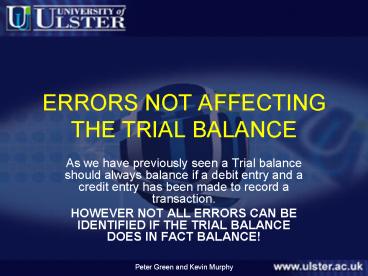ERRORS NOT AFFECTING THE TRIAL BALANCE - PowerPoint PPT Presentation
1 / 13
Title:
ERRORS NOT AFFECTING THE TRIAL BALANCE
Description:
... account which should be debited, then the trial balance will still balance, even ... This is because both the debit side and the credit side of the trial balance ... – PowerPoint PPT presentation
Number of Views:981
Avg rating:3.0/5.0
Title: ERRORS NOT AFFECTING THE TRIAL BALANCE
1
ERRORS NOT AFFECTING THE TRIAL BALANCE
- As we have previously seen a Trial balance should
always balance if a debit entry and a credit
entry has been made to record a transaction. - HOWEVER NOT ALL ERRORS CAN BE IDENTIFIED IF THE
TRIAL BALANCE DOES IN FACT BALANCE!
2
COMPLETE REVERSAL OF ENTRIES
- We have studied this before, but if double
entries are completely reversed, i.e. we debit an
account which should be credited, and credit an
account which should be debited, then the trial
balance will still balance, even though the
transaction has been recorded, completely
incorrectly.
3
ERRORS OF OMISSION
- Where a transaction is completely omitted from
the accounting records, the trial balance will
still balance, provided that all of the other
transactions have been recorded by a debit and
credit entry. - Note, it will still balance if the entries for
the other transactions have been completely
reversed.
4
ERRORS OF COMMISSION
- This type of error occurs when the correct amount
is entered, but in the wrong persons account. - For example, a credit sale of 11 to C. Green is
correctly recorded in the Sales Day Book, but is
debited to K. Greens personal account in the
Sales Ledger. - The records will show that a credit sale of 11
has been made, but would incorrectly indicate
that K. Green owes the business (a debtor) 11,
when in fact C. Green owes the business (a
debtor) 11.
5
ERRORS OF PRINCIPLE
- This is where an item is entered in the wrong
class (type of account), although a double entry,
i.e. debit entry and credit entry has been made,
even if the double entry has been completely
reversed. - For example, if a florist purchases a delivery
van (fixed asset) by cheque, but debits the motor
expenses account (whilst crediting the bank
account) which, when preparing the financial
statements, is treated as an expense in the
profit and loss account, the trial balance will
balance (a debit and a credit entry has been
made), but the profit of the business will be
understated when the financial statements are
prepared.
6
COMPENSATING ERRORS
- This occurs when errors effectively cancel each
other out. - For example, if the sales account was added up to
be 10 more than it actually is, whilst at the
same time, the purchases account was also added
up to be 10 more than it actually is, then these
two errors would cancel out (compensate) when the
trial balance is prepared. - This is because both the debit side and the
credit side of the trial balance will be 10 too
much.
7
REVIEW QUESTION
- If the Sales Day Book and the Purchases Day book,
were both added up to be 10 more than the
correct figure, and all other entries, i.e. to
the personal accounts been made correctly, would
the trial balance still balance? - This is one of the reasons why we prepare control
accounts, which we will study next.
8
CASTING
- The term casting means adding up.
- Overcasting as in this example, means adding up a
column of figures to give an answer which is
greater than it should be. - Undercasting means incorrectly adding up a column
of figures to give an answer which is less than
it should be.
9
ERRORS OF ORIGINAL ENTRY
- This occurs when the original figure recorded is
incorrect. - For example, a credit sale of 150, may have been
recorded in the Sales Day Book as a credit sale
of 130, and the correct double entry made (using
the recorded amount) in the personal account of
the debtor in the Sales Ledger. - The result of this would be that sales in the
profit and loss account would be understated by
20, and debtors, as per the Sales Ledger would
also be understated by 20. - HOWEVER, THE TRIAL BALANCE WOULD STILL BALANCE.
10
TRANSPOSITION ERRORS
- This occurs where the wrong sequence of the
individual characters within a number is entered. - For example, in the Sales Day Book a credit sale
of 142 is recorded as 124. - If the double entry (even if completely reversed)
is made, the trial balance will still balance. - This is quite a common problem and it is
difficult to detect if the error has occurred in
both the debit and the credit entries. - However, it is more common for this type of error
to occur on only one side (debit or credit) of
the double entry.
11
CORRECTION OF ERRORS
- Most errors are eventually discovered.
- However, when they are discovered, we should NOT
correct them by crossing out figures, tearing out
accounts or using chemicals to remove the error. - Corrections to double entry accounts should be
made via the journal, in order that there remains
a permanent record of the actual mistake and how
it was corrected.
12
CORRECTION OF ERRORS
- We should
- SHOW THE CORRECTIONS BY MEANS OF JOURNAL ENTRIES.
- SHOW THE CORRECTIONS IN THE DOUBLE ENTRY SET OF
ACCOUNTS, BY POSTING THESE JOURNAL ENTRIES TO THE
LEDGERS AFFECTED.
13
CORRECTION OF ERRORS
- On pages 379 to 382, examples are given of
journal corrections. - You should study these as private study.
- You will be required to use journal corrections
in Seminar questions.































